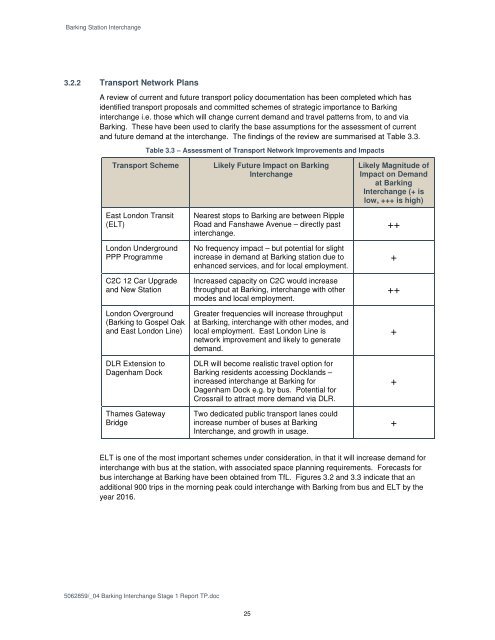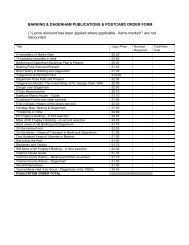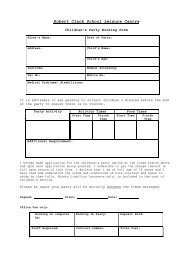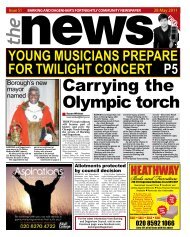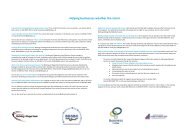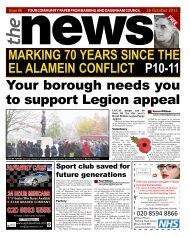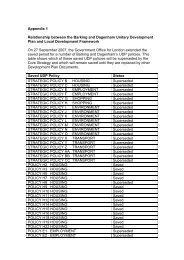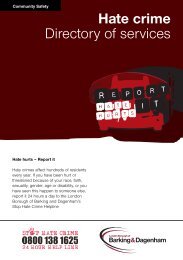Contents - Barking & Dagenham
Contents - Barking & Dagenham
Contents - Barking & Dagenham
Create successful ePaper yourself
Turn your PDF publications into a flip-book with our unique Google optimized e-Paper software.
<strong>Barking</strong> Station Interchange<br />
3.2.2 Transport Network Plans<br />
A review of current and future transport policy documentation has been completed which has<br />
identified transport proposals and committed schemes of strategic importance to <strong>Barking</strong><br />
interchange i.e. those which will change current demand and travel patterns from, to and via<br />
<strong>Barking</strong>. These have been used to clarify the base assumptions for the assessment of current<br />
and future demand at the interchange. The findings of the review are summarised at Table 3.3.<br />
5062859/_04 <strong>Barking</strong> Interchange Stage 1 Report TP.doc<br />
Table 3.3 – Assessment of Transport Network Improvements and Impacts<br />
Transport Scheme Likely Future Impact on <strong>Barking</strong><br />
Interchange<br />
East London Transit<br />
(ELT)<br />
London Underground<br />
PPP Programme<br />
C2C 12 Car Upgrade<br />
and New Station<br />
London Overground<br />
(<strong>Barking</strong> to Gospel Oak<br />
and East London Line)<br />
DLR Extension to<br />
<strong>Dagenham</strong> Dock<br />
Thames Gateway<br />
Bridge<br />
Nearest stops to <strong>Barking</strong> are between Ripple<br />
Road and Fanshawe Avenue – directly past<br />
interchange.<br />
No frequency impact – but potential for slight<br />
increase in demand at <strong>Barking</strong> station due to<br />
enhanced services, and for local employment.<br />
Increased capacity on C2C would increase<br />
throughput at <strong>Barking</strong>, interchange with other<br />
modes and local employment.<br />
Greater frequencies will increase throughput<br />
at <strong>Barking</strong>, interchange with other modes, and<br />
local employment. East London Line is<br />
network improvement and likely to generate<br />
demand.<br />
DLR will become realistic travel option for<br />
<strong>Barking</strong> residents accessing Docklands –<br />
increased interchange at <strong>Barking</strong> for<br />
<strong>Dagenham</strong> Dock e.g. by bus. Potential for<br />
Crossrail to attract more demand via DLR.<br />
Two dedicated public transport lanes could<br />
increase number of buses at <strong>Barking</strong><br />
Interchange, and growth in usage.<br />
25<br />
Likely Magnitude of<br />
Impact on Demand<br />
at <strong>Barking</strong><br />
Interchange (+ is<br />
low, +++ is high)<br />
ELT is one of the most important schemes under consideration, in that it will increase demand for<br />
interchange with bus at the station, with associated space planning requirements. Forecasts for<br />
bus interchange at <strong>Barking</strong> have been obtained from TfL. Figures 3.2 and 3.3 indicate that an<br />
additional 900 trips in the morning peak could interchange with <strong>Barking</strong> from bus and ELT by the<br />
year 2016.<br />
++<br />
+<br />
++<br />
+<br />
+<br />
+


